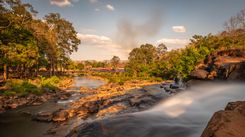A wide slice of terrain wedged between China’s Yunnan and Vietnam’s Lai Chau provinces, Phongsali province would surely be a part of China today were it not for the covetous nineteenth-century French. During the Second Indochina War, Phongsali came under heavy Chinese influence, a fact evident in the fortress-like former Chinese consulate, now the Phou Fa Hotel. It was during this time also that much of the province was stripped of its hardwood forests, compensation for China’s support for the Pathet Lao. The town’s inhabitants are made up of the Theravada Buddhist, Tibeto-Burman-speaking Phu Noi people and the Chinese Haw, descendants of Yunnanese traders who annually drove caravans of pack-ponies south into old Siam.
On a slope directly behind the Phongsaly Hotel is the town’s old quarter. A wander through these friendly but medieval-looking lanes is like stepping back in time. Interspersed among the squat houses of mud bricks and rough-hewn planks are a few architectural standouts, including one distinctly Chinese building with a beautifully carved wooden facade that looks like it belongs on the backstreets of old Kunming. The quarter’s three main streets run parallel for a stretch and then converge at a large basketball court, from which leads Phongsali’s main commercial thoroughfare, a tidy street of low shophouses, some with roofs constructed of oil drums hammered flat and laid out like shingles. Situated on the opposite bank of the town’s green bathing pond is Wat Kaeo, the local monastery.
Anyone interested in seeing what Phongsali’s ethnic groups dressed like before the influx of cheap Western-style clothing from China should pay a visit to the Museum of Tribes on the main road. Unfortunately, the rather small display of costumes and traditional wooden utensils isn’t done any favours by its lack of English explanations.
The nearby market is fairly small, considering this is a provincial capital, but as usual is a good bet for a cheap bowl of noodles. It’s worth making the stiff but not unpleasant walk up the forested hillside of Phou Fa hill, the top of which offers excellent views over the town and surrounding countryside on a clear day.
The main attraction of a visit to Phongsali is the opportunity to trek in this beautiful region. At the time of writing, the only treks available were offered by the tourist office, which clearly outlines where your money will go. Tours range from one- to multi-day treks, taking in local hill-tribe villages, with prices ranging according to the size of the group.




